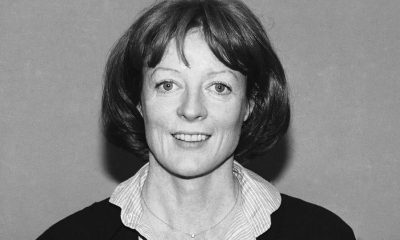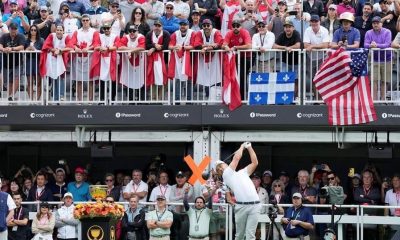
Photo: Tadayuki Minamoto/Calder Foundation New York/Artists Rights Society, New York
Editor’s Note: This story originally appeared in Breakfast With ARTnews, our daily newsletter about the art world. Sign up here to receive it every weekday.
The flight to Japan from art world centers like New York, London, and Paris isn’t exactly short. Those that do make the trip this year, however, won’t be disappointed with the art offerings, which span modern to contemporary. This week, during the Tokyo Gendai fair, the shows to see in the city are dominated by strong sculpture.
First up on the itinerary: the Artizon Museum’s exhibition of Constantin Brancusi, the first proper survey of the Romanian-born sculptor’s work in Japan.
Brancusi’s The Kiss has it all: it’s cute, it’s romantic, it’s profoundly Instagrammable. Made at the turn of the twentieth century, it also happens to mark the starting line of modern sculpture: from The Kiss’s economy of means, the rest was a sprint, from Picasso to Moore to Giacometti all the way up through Eva Hesse and Rachel Whiteread. So it’s no surprise that the Kiss is situated front and center at the Artizon show.
The exhibition neatly charts Brancusi’s wiggling free of Rodin’s influence and taking flight: the show culminates in a section dedicated to the form of the bird, represented by the rightly famous Bird in Space, an elegant skyward swipe of bronze. There are also photographs, and a section dedicated to recreating Brancusi’s Montparnasse studio. Purists will gripe about the large number of posthumous casts but, for a lay audience, the show serves as a decent dose of beauty and a fine introduction to a titan of modern sculpture.

Photo: Tadayuki Minamoto/Calder Foundation New York/Artists Rights Society, New York
If Brancusi conceived of the bird, Alexander Calder taught it to fly. Over at the Azabudai Hills Gallery is a compact survey of the master of the mobile—done in collaboration with Pace Gallery , whose huge new space is upstairs—assembled by the artist’s tireless grandson Sandy Rower, head of the Calder Foundation. The title? “Calder: A Japanese Effect” Why not. We’ve already had Calder paired with artists from Giacometti to Miro to Fischli and Weiss. As Rower has shown us over the past two decades, Calder is indeed the gift that keeps on giving.
There are some real gems in this exhibition, including an unexpected series of drawings of animals in motion: there are no other words for these than just perfect, especially the cats, with their movements captured in just a few strokes of ink. A star of this particular show, though, is Japanese architect Stephanie Goto, who did the exhibition design. A black mobile set against a black ceiling? Unexpectedly brilliant. Other works are situated against a wall covered in large black sheets of paper, another effect that shouldn’t work but does.

You may think of Brancusi again when you visit “MOON,” an exhibition of Los Angeles-based British artist Thomas Houseago at BLUM , the gallery formerly known as Blum & Poe. Best known as a sculptor, Houseago has several pieces in the show that recall the Romanian master, one of them an abstract egg-like shape set on a rough-hewn wooden plinth, and the other an owl in his signature technique of drawing in plaster.
For my money, the owl is the best piece in this show, displayed silhouetted against a large window. Like Ann Craven’s paintings of birds, this piece seems to capture the essence of the animal. Houseago has recently branched out into paintings, and they are dramatic and rich with color, if somewhat less successful than the 3D work. A large painting of an owl, for instance, is accomplished, but seems only to highlight the less-is-more brilliance of the sculpture.
After seeing the work of those three male sculptors, you will have to put on a different hat to experience the work of Rei Naito. Think of Henry James’s famous dictum and “try to be one of those on whom nothing is lost.” Because if you are not paying attention in the various displays of Naito’s work throughout the enormous Tokyo National Museum, you are going to lose quite a bit.
Naito, who was born in Hiroshima in 1961 and represented Japan at the 1997 Venice Biennale, works in a minimalist tradition, but not in the sense of, say, Donald Judd. There is nothing heavy about her work. Instead, objects ranging from small to miniscule—pompoms, balloons, pebble-like blown glass bubbles, animal figurines, bones, little mirrors, a jar of water—are deployed in ways that demand meditation on the part of the viewer. In one long, narrow gallery of the museum, such things are arrayed against slate gray walls and under dimmed lights: the effect is of being inside the artist’s imagination. Along one wall is white fabric inside a glass display case, looking like a snowbank. What amazes about Saito’s work is just how close it gets to twee without ever stepping over that line.

Photo: Nobutada Omote/Courtesy the artist and SCAI THE BATHHOUSE.
In the 1980s, Naito said of a particular artwork of hers that she was attempting to “create a spiritual place of her own.” The same might be said for another Japanese artist of Naito’s generation who works in a very different mode. Mariko Mori became known in the nineties for photographs of herself posed in urban environments in Japan, dressed up as various stereotypes of a Japanese woman. But over the past two decades she has been working in a spiritual mode, right down to merging her art with her living quarters.
The project currently on view at SCAI The Bathhouse is complex, involving crystals and a spiritualistic painting, and is connected to Mori’s artwork Peace Crystal (2016-2024), which is currently on view outside a palazzo in Venice during this year’s Biennale. At SCAI, Mori appears in augmented reality (you need to make an appointment) as a priestess whose attire draws on both Japan’s history and on the kind of futuristic effects found in video games. Like Saito, Mori has crafted an entire immersive world, one you can only enter in person.

Photo: Koroda Takeru/Courtesy Mori Art Museum
For Theaster Gates, too, as a wall text explains in the Chicago artist’s first solo exhibition in Japan, at the Mori Art Museum , making art is a spiritual enterprise. Gates prepared for the Mori show by working with potters in Tokoname, which he had first visited in 2004, and came up with the concept of “Afro-Mingei,” a reference to the word for Japanese folk art, a movement that was overshadowed by the introduction of Western art to Japan in the 19th century. (“[W]hat is key for me is the way in which Mingei honors makers native to a place and resists external impositions of cultural identity,” Gates explains in wall text in the show.)
The results are displayed in the final section of this survey of Gates’ work and they are by far the highlight. After an elaborate timeline that traces Gates’ links with Japan comes an enormous display case holding ceramics by Tokoname potter Koide Yoshihiro, who died in 2022, and an enormous wooden bar—stools and all—that fronts a set of shelves holding binbo tokkuri bottles (sake bottles) made in collaboration with Japanese potter Tani Q. There’s also a terrific soundtrack (Busta Rhymes was on when I visited) and a spinning disco ball in the shape of an iceberg.


LONDON (AP) — With a few daubs of a paintbrush, the Brontë sisters have got their dots back.
More than eight decades after it was installed, a memorial to the three 19th-century sibling novelists in London’s Westminster Abbey was amended Thursday to restore the diaereses – the two dots over the e in their surname.
The dots — which indicate that the name is pronounced “brontay” rather than “bront” — were omitted when the stone tablet commemorating Charlotte, Emily and Anne was erected in the abbey’s Poets’ Corner in October 1939, just after the outbreak of World War II.
They were restored after Brontë historian Sharon Wright, editor of the Brontë Society Gazette, raised the issue with Dean of Westminster David Hoyle. The abbey asked its stonemason to tap in the dots and its conservator to paint them.
“There’s no paper record for anyone complaining about this or mentioning this, so I just wanted to put it right, really,” Wright said. “These three Yorkshire women deserve their place here, but they also deserve to have their name spelled correctly.”
It’s believed the writers’ Irish father Patrick changed the spelling of his surname from Brunty or Prunty when he went to university in England.
Raised on the wild Yorkshire moors, all three sisters died before they were 40, leaving enduring novels including Charlotte’s “Jane Eyre,” Emily’s “Wuthering Heights” and Anne’s “The Tenant of Wildfell Hall.”
Rebecca Yorke, director of the Brontë Society, welcomed the restoration.
“As the Brontës and their work are loved and respected all over the world, it’s entirely appropriate that their name is spelled correctly on their memorial,” she said.
The Canadian Press. All rights reserved.

In a case that has sent shockwaves through the Vancouver Island art community, a local art dealer has been charged with one count of fraud over $5,000. Calvin Lucyshyn, the former operator of the now-closed Winchester Galleries in Oak Bay, faces the charge after police seized hundreds of artworks, valued in the tens of millions of dollars, from various storage sites in the Greater Victoria area.
Alleged Fraud Scheme
Police allege that Lucyshyn had been taking valuable art from members of the public under the guise of appraising or consigning the pieces for sale, only to cut off all communication with the owners. This investigation began in April 2022, when police received a complaint from an individual who had provided four paintings to Lucyshyn, including three works by renowned British Columbia artist Emily Carr, and had not received any updates on their sale.
Further investigation by the Saanich Police Department revealed that this was not an isolated incident. Detectives found other alleged victims who had similar experiences with Winchester Galleries, leading police to execute search warrants at three separate storage locations across Greater Victoria.
Massive Seizure of Artworks
In what has become one of the largest art fraud investigations in recent Canadian history, authorities seized approximately 1,100 pieces of art, including more than 600 pieces from a storage site in Saanich, over 300 in Langford, and more than 100 in Oak Bay. Some of the more valuable pieces, according to police, were estimated to be worth $85,000 each.
Lucyshyn was arrested on April 21, 2022, but was later released from custody. In May 2024, a fraud charge was formally laid against him.
Artwork Returned, but Some Remain Unclaimed
In a statement released on Monday, the Saanich Police Department confirmed that 1,050 of the seized artworks have been returned to their rightful owners. However, several pieces remain unclaimed, and police continue their efforts to track down the owners of these works.
Court Proceedings Ongoing
The criminal charge against Lucyshyn has not yet been tested in court, and he has publicly stated his intention to defend himself against any pending allegations. His next court appearance is scheduled for September 10, 2024.
Impact on the Local Art Community
The news of Lucyshyn’s alleged fraud has deeply affected Vancouver Island’s art community, particularly collectors, galleries, and artists who may have been impacted by the gallery’s operations. With high-value pieces from artists like Emily Carr involved, the case underscores the vulnerabilities that can exist in art transactions.
For many art collectors, the investigation has raised concerns about the potential for fraud in the art world, particularly when it comes to dealing with private galleries and dealers. The seizure of such a vast collection of artworks has also led to questions about the management and oversight of valuable art pieces, as well as the importance of transparency and trust in the industry.
As the case continues to unfold in court, it will likely serve as a cautionary tale for collectors and galleries alike, highlighting the need for due diligence in the sale and appraisal of high-value artworks.
While much of the seized artwork has been returned, the full scale of the alleged fraud is still being unraveled. Lucyshyn’s upcoming court appearances will be closely watched, not only by the legal community but also by the wider art world, as it navigates the fallout from one of Canada’s most significant art fraud cases in recent memory.
Art collectors and individuals who believe they may have been affected by this case are encouraged to contact the Saanich Police Department to inquire about any unclaimed pieces. Additionally, the case serves as a reminder for anyone involved in high-value art transactions to work with reputable dealers and to keep thorough documentation of all transactions.
As with any investment, whether in art or other ventures, it is crucial to be cautious and informed. Art fraud can devastate personal collections and finances, but by taking steps to verify authenticity, provenance, and the reputation of dealers, collectors can help safeguard their valuable pieces.
[unable to retrieve full-text content]
Ukrainian sells art in Essex while stuck in a warzone BBC.com

Source link


Maggie Smith, scene-stealing actor famed for Harry Potter and ‘Downton Abbey,’ dies at 89


Bob Geldof hopes Live Aid musical inspires younger generation to take action


Israel-Hamas war latest: Israel carries out attacks in Beirut on Hezbollah targets


Netanyahu, at UN, vows that Israel will keep ‘degrading Hezbollah’ until its objectives are met


As political scandal grips NYC, a fictional press conference puzzles some New Yorkers


Harris walks fence at US-Mexico border as she works to project tougher stance on migration


Montreal police make arrest in Presidents Cup golf apparel theft


Mexican authorities uncover 24 drug cartel surveillance cameras in city on the border with Arizona